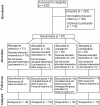The effect of 12 weeks of aerobic, resistance or combination exercise training on cardiovascular risk factors in the overweight and obese in a randomized trial
- PMID: 23006411
- PMCID: PMC3487794
- DOI: 10.1186/1471-2458-12-704
The effect of 12 weeks of aerobic, resistance or combination exercise training on cardiovascular risk factors in the overweight and obese in a randomized trial
Abstract
Background: Evidence suggests that exercise training improves CVD risk factors. However, it is unclear whether health benefits are limited to aerobic training or if other exercise modalities such as resistance training or a combination are as effective or more effective in the overweight and obese. The aim of this study is to investigate whether 12 weeks of moderate-intensity aerobic, resistance, or combined exercise training would induce and sustain improvements in cardiovascular risk profile, weight and fat loss in overweight and obese adults compared to no exercise.
Methods: Twelve-week randomized parallel design examining the effects of different exercise regimes on fasting measures of lipids, glucose and insulin and changes in body weight, fat mass and dietary intake. Participants were randomized to either: Group 1 (Control, n = 16); Group 2 (Aerobic, n = 15); Group 3 (Resistance, n = 16); Group 4 (Combination, n = 17). Data was analysed using General Linear Model to assess the effects of the groups after adjusting for baseline values. Within-group data was analyzed with the paired t-test and between-group effects using post hoc comparisons.
Results: Significant improvements in body weight (-1.6%, p = 0.044) for the Combination group compared to Control and Resistance groups and total body fat compared to Control (-4.4%, p = 0.003) and Resistance (-3%, p = 0.041). Significant improvements in body fat percentage (-2.6%, p = 0.008), abdominal fat percentage (-2.8%, p = 0.034) and cardio-respiratory fitness (13.3%, p = 0.006) were seen in the Combination group compared to Control. Levels of ApoB48 were 32% lower in the Resistance group compared to Control (p = 0.04).
Conclusion: A 12-week training program comprising of resistance or combination exercise, at moderate-intensity for 30 min, five days/week resulted in improvements in the cardiovascular risk profile in overweight and obese participants compared to no exercise. From our observations, combination exercise gave greater benefits for weight loss, fat loss and cardio-respiratory fitness than aerobic and resistance training modalities. Therefore, combination exercise training should be recommended for overweight and obese adults in National Physical Activity Guidelines.This clinical trial was registered with the Australian New Zealand Clinical Trials Registry (ANZCTR), registration number: ACTRN12609000684224.
Figures



References
-
- Physical Activity Guidelines Advisory Committee. Physical Activity Guidelines Advisory Committee Report. U.S. Department of Health and Human Services, Washington, DC; 2008. - PubMed
-
- National Health and Medical Research Council. National Physical Activity Guidelines for Australians. Australian Government Publishing Service, Canberra; 1999.
-
- Dumortier M, Brandou F, Perez-Martin A, Fedou C, Mercier J, Brun JF. Low intensity endurance exercise targeted for lipid oxidation improves body composition and insulin sensitivity in patients with the metabolic syndrome. Diabetes Metab. 2003;29:509–518. doi: 10.1016/S1262-3636(07)70065-4. - DOI - PubMed
-
- Johnson JL, Slentz CA, Houmard JA, Samsa GP, Duscha BD, Aiken LB, McCartney JS, Tanner CJ, Kraus WE. Exercise training amount and intensity effects on metabolic syndrome (from Studies of a Targeted Risk Reduction Intervention through Defined Exercise) Am J Cardiol. 2007;100:1759–1766. doi: 10.1016/j.amjcard.2007.07.027. - DOI - PMC - PubMed
Publication types
MeSH terms
Substances
LinkOut - more resources
Full Text Sources
Medical

